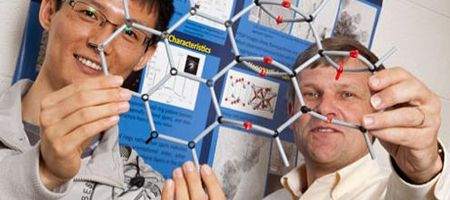Scientists and engineers at the University of Wisconsin-Milwaukee have discovered a completely new carbon-based material, synthesized from graphene, which could mark a big step towards faster electronics.

While transistors based on graphene are widely expected to take over from current devices, they’re expensive to mass-produce. Another problem is that, until now, graphene-related materials existed only as conductors or insulators.
“A major drive in the graphene research community is to make the material semiconducting so it can be used in electronic applications,” says professor of mechanical engineering Junhong Chen. “Our major contribution in this study was achieved through a chemical modification of graphene.”
The new material, graphene monoxide or GMO, will be easier to scale up than graphene, says the team. And, like silicon, it’s semiconducting, so that electrical current can be controlled.
“Now all three characteristics of electrical conductivity – conducting, insulating and semiconducting – are found in the carbon family, offering needed compatibility for use in future electronics,” says the team.
The team created GMO by accident, while conducting research into the behavior of a hybrid nanomaterial consisting of carbon nanotubes and tin oxide nanoparticles.
In one experiment, they heated graphene oxide in a vacuum to reduce oxygen. Instead of being destroyed, however, the carbon and oxygen atoms in the layers of GO became aligned, transforming themselves into the ‘ordered’, semiconducting GMO – a carbon oxide that doesn’t exist in nature.
At different high temperatures, the team actually produced four new versions of the material.
Because GMO is formed in single sheets, the team says the material could have applications in products that involve surface catalysis. The scientists are now exploring its use in the anode parts of lithium-ion batteries, hoping to make them more efficient.






